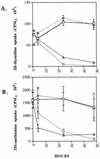Partial purification and characterization of biological effects of a lipid toxin produced by Mycobacterium ulcerans
- PMID: 9453613
- PMCID: PMC107944
- DOI: 10.1128/IAI.66.2.587-593.1998
Partial purification and characterization of biological effects of a lipid toxin produced by Mycobacterium ulcerans
Abstract
Organisms in the genus Mycobacterium cause a variety of human diseases. One member of the genus, M. ulcerans, causes a necrotizing skin disease called Buruli ulcer. Buruli ulcer is unique among mycobacterial diseases in that the organisms at the site of infection are extracellular and there is little acute inflammatory response. Previous literature reported the presence of a toxin in the culture supernatant of M. ulcerans which causes a cytopathic effect on the mouse fibroblast cell line L929 in which the adherent cells round up and detach from the tissue culture plate. Here we report partial purification of a lipid toxin from the culture supernatant of M. ulcerans which is capable of causing the cytopathic effect on L929 cells. We also show that this cytopathic effect is a result of cytoskeletal rearrangement. The M. ulcerans toxin does not cause cell death but instead arrests cells in the G1 phase of the cell cycle.
Figures






References
-
- Adams J L, Czuprynski C J. Mycobacterial cell wall components induce the production of TNF-α, IL-1, and IL-6 by bovine monocytes and the murine macrophage cell line RAW 264.7. Microb Pathog. 1995;16:401–411. - PubMed
-
- Aktories K. Rho proteins: targets for bacterial toxins. Trends Microbiol. 1997;5:282–288. - PubMed
-
- Behling C A, Perex R L, Kidd M R, Staton G W, Jr, Hunter R L. Induction of pulmonary granulomas, macrophage procoagulant activity, and tumor necrosis factor-alpha by trehalose glycolipids. Ann Clin Lab Sci. 1993;23:256. - PubMed
MeSH terms
Substances
LinkOut - more resources
Full Text Sources
Other Literature Sources

